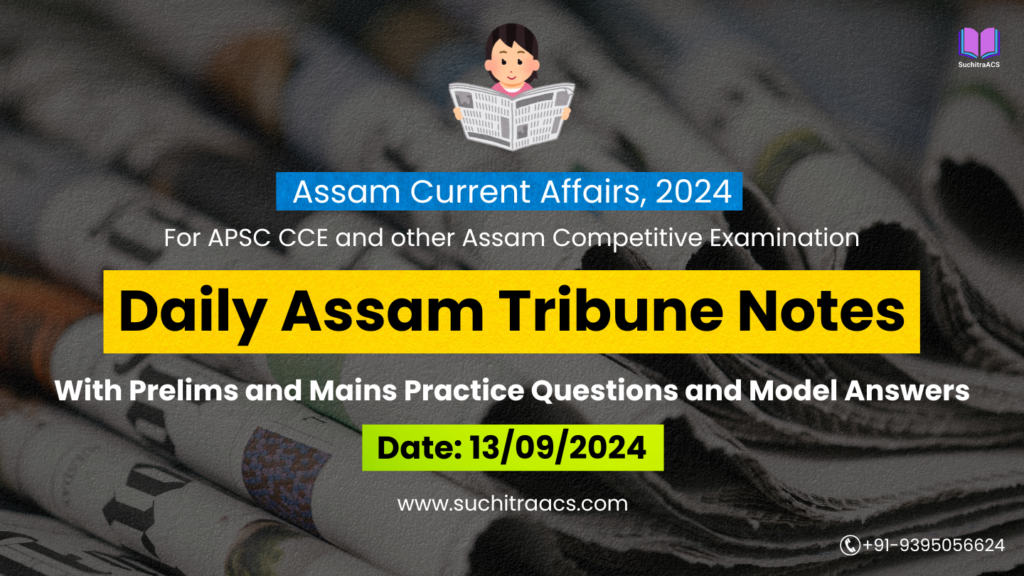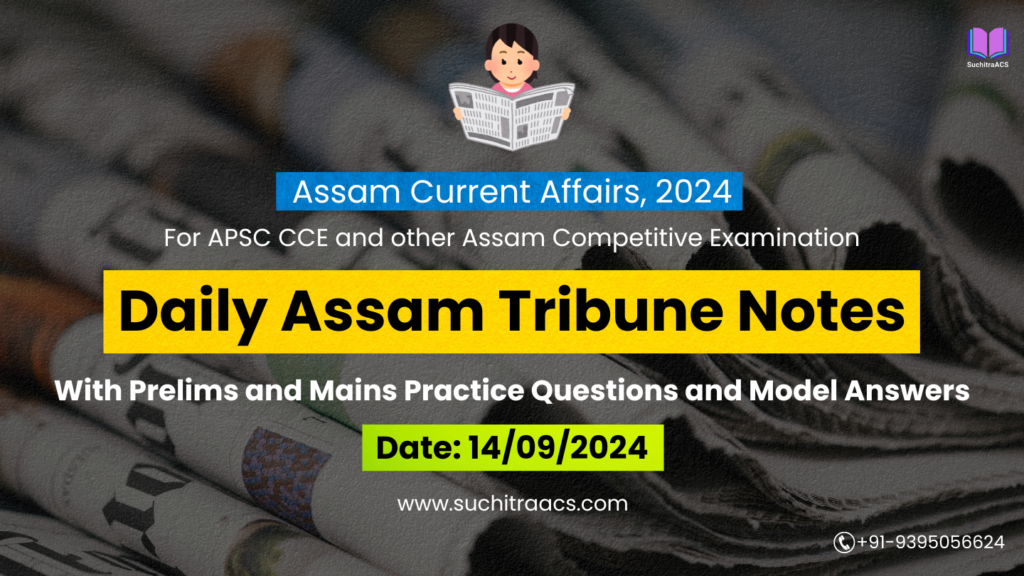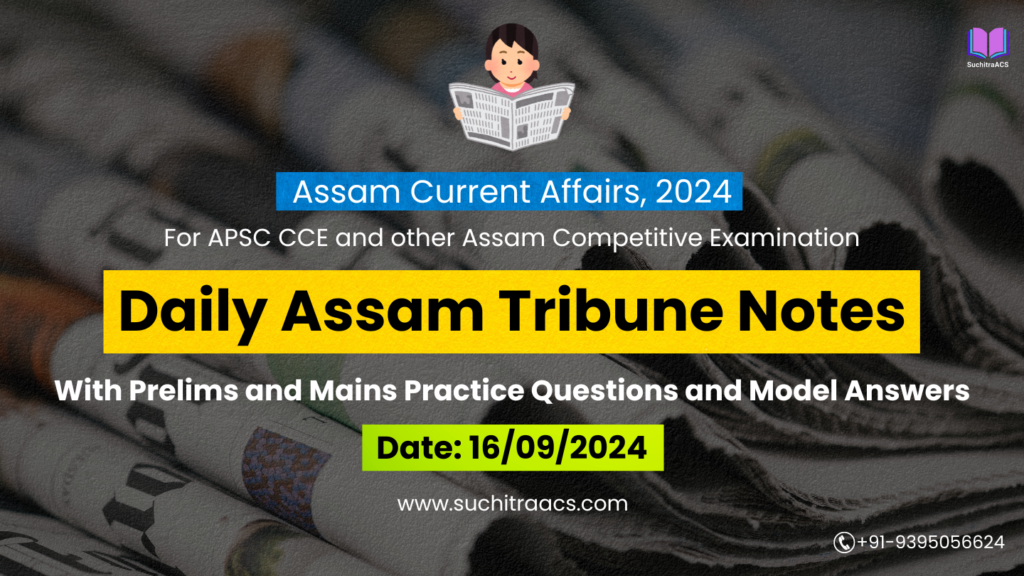APSC Current Affairs: Assam Tribune Notes with MCQs and Answer Writing (28/04/2025)
For APSC CCE and other Assam Competitive examinations aspirants, staying updated with current affairs is vital. This blog covers most important topics from the Assam Tribune today (28-04-2025). These issues are key for both APSC Prelims and Mains preparation, offering insights into the APSC CCE Syllabus.
✨ Current Affairs Crash Course for the APSC Prelims 2025

📚 Assam’s Major Education Infrastructure Upgrade Plan
📘 GS Paper 2: Governance | Education Sector Reforms
📘 GS Paper 3: Infrastructure | Human Resource Development
🔹 Introduction
The Government of Assam has launched a massive initiative to rebuild and upgrade the infrastructure of its government-run high and higher secondary schools. The project, spearheaded by Chief Minister Himanta Biswa Sarma, aims to construct new buildings for around 200 schools every year until 2035, focusing on reversing declining enrollment trends, especially in Assamese-medium schools.
🔑 Key Points
| Feature | Description |
| Initiative | Construction of new buildings for 4,000 high and higher secondary schools |
| Target Completion | By 2035 (200 schools annually) |
| Funding | ₹8 crore allocated per school; Total outlay ~₹32,000 crore |
| Current Phase | Initial construction for 500 schools |
| Problem Addressed | Poor infrastructure leading to drop in enrollment in Assamese-medium schools |
| Additional Steps | Introduction of English-medium sections in selected schools |
| Subjects in English | Science and Mathematics |
| Related Reforms | Concept-based questions introduced in HSLC examinations |
| Community Involvement | Bihu committees, Puja committees encouraged to assist in tutoring initiatives |
⚙️ Special Features
Resource Optimization:
Schools with low enrollment are merged with nearby institutions.
Bilingual Instruction:
Both Assamese and English mediums offered to fulfill aspirations of all sections.
Focus on Competitive Exams:
Evening tutoring initiatives planned to prepare students better for board and entrance exams.
Community-Driven Support:
Local committees to be financially supported for arranging free coaching classes.
🧠 Prelims Pointers
HSLC: High School Leaving Certificate examination of Assam Board (SEBA).
Concept-Based Learning: Focus on application and critical thinking rather than rote memorization.
State Education Infrastructure Scheme: Assam’s independent mega project, unlike centrally sponsored RMSA or Samagra Shiksha.
Rangmahal High School (North Guwahati) and Gurdon HS School (Nalbari): Early models for bilingual education.
Vision 2035: Assam’s larger blueprint aligning with Sustainable Development Goals (SDGs).
📝 Mains Pointers
A. Importance of the Initiative
| Benefit | Impact |
| Improved Access and Quality | Modern classrooms, labs, libraries in rural and semi-urban belts |
| Preserving Assamese Language | Stronger support to Assamese-medium schools |
| Socio-Economic Mobility | Quality education for economically weaker sections |
| Skill Development | Boost STEM (Science, Technology, Engineering, Math) learning early on |
B. Challenges Ahead
| Challenge | Explanation |
| Execution Delays | Vast number of constructions may strain administrative capacity |
| Quality Control | Ensuring uniform construction standards across districts |
| Teacher Shortage | Modern infrastructure must be matched with qualified teachers |
| Urban-Rural Disparity | Remote schools may face slow progress due to logistical hurdles |
C. Way Forward
Third-Party Audits
Regular evaluation by independent agencies to maintain transparency.
Capacity Building
Special training programs for teachers to align with modern pedagogy.
Community Ownership
Strengthen school management committees (SMCs) to oversee infrastructure maintenance.
Digital Integration
Set up smart classrooms, IT labs, and hybrid learning models alongside construction.
🧩 Conclusion
The school infrastructure upgrade plan of Assam is a visionary leap towards bridging educational inequalities and equipping the next generation for a globally competitive future. If implemented with speed, sensitivity, and sustainability, this could serve as a model for educational reforms in other Indian states as well.
🚔 Assam Cracks Down on Coal Syndicate: Push for Clean Governance
📘 GS Paper 2: Governance | Transparency and Accountability | Ethics in Public Administration
📘 GS Paper 3: Internal Security | Organized Crime
🔹 Introduction
The Assam government has launched a major crackdown against the illegal coal syndicate networks operating between Assam, Meghalaya, and West Bengal. The state police arrested several influential operators and middlemen involved in coal smuggling, illegal taxation, and black-market transactions.
This move is part of Assam’s wider drive for clean governance, resource security, and organized crime control.
🔑 Key Points
| Feature | Description |
| Operation Name | Operation Against Illegal Coal Syndicates (unofficially termed) |
| Key Areas Affected | Goalpara, Dima Hasao, Guwahati outskirts, Jorabat, Byrnihat |
| Key Actions Taken | Arrests of kingpins, seizure of trucks, freezing of suspicious bank accounts |
| Political Angle | Assam CM issued stern warning against political patronage of syndicates |
| Broader Focus | Smuggling networks involving coal, betel nuts, cattle, drugs |
| Future Measures | Use of drone surveillance and AI-based border monitoring tools |
⚙️ Background Context
Coal Mining in Meghalaya:
Predominantly unscientific and often illegal (“rat-hole mining”), despite NGT (National Green Tribunal) bans.
Syndicate Networks:
Informal mafia groups levy unofficial “taxes” on movement of goods, affecting small traders, inflating black money.
Previous Political Tussles:
Allegations of police–politician–businessmen nexus sheltering coal and cattle syndicates.
🧠 Prelims Pointers
Rat-Hole Mining: Banned mining technique involving narrow, unsafe tunnels, prevalent in Meghalaya.
National Green Tribunal (NGT): Statutory body for handling environmental protection and legal cases.
Assam Police Special Branch: Intelligence arm involved in organized crime tracking.
Prevention of Money Laundering Act (PMLA): Used to probe illegal profits from syndicates.
📝 Mains Pointers
A. Significance of the Crackdown
| Aspect | Impact |
| Resource Governance | Protects state revenue from leakage; ensures proper mineral accounting |
| Rule of Law | Strengthens public trust in government’s commitment to fight organized crime |
| Economic Efficiency | Reduces informal taxes; lowers logistics costs for genuine businesses |
| National Security | Syndicates often linked with cross-border trafficking and insurgent funding |
B. Challenges in Eliminating Coal Syndicates
| Challenge | Explanation |
| Deep-rooted Patronage | Political and administrative collusion hard to dismantle |
| Alternative Livelihoods | Miners and transporters dependent on illegal trade need reskilling |
| Border Porosity | Assam–Meghalaya–West Bengal borders difficult to regulate fully |
| Retaliation Risks | Threats to whistleblowers, police officers leading anti-syndicate actions |
C. Way Forward
Technology-Driven Surveillance
Use drones, RFID-tagged vehicles, AI-based pattern recognition for movement tracking.
Legal Reforms
Fast-track courts for organized crime cases under special statutes like MCOCA (if adapted).
Alternative Employment
Launch skilling missions for those dependent on mining and transport sectors.
Public Awareness Campaigns
Mobilize citizens against coal mafias through media, schools, and PRIs (Panchayati Raj Institutions).
Interstate Coordination
Establish a NE Mineral Movement Task Force involving Assam, Meghalaya, and Bengal.
🧩 Conclusion
The coal syndicate crackdown marks a bold shift towards transparent governance and resource sovereignty in Assam. To sustain this momentum, the government must pair strong policing with institutional reforms, economic rehabilitation, and community engagement.
🎓 Gauhati University’s Rise in NIRF Rankings: A Boost for Higher Education in Assam
📘 GS Paper 2: Education | Government Policies
📘 GS Paper 3: Human Resource Development | Innovation Ecosystem
🔹 Introduction
Gauhati University (GU), Assam’s premier institution, has recorded a significant jump in the NIRF (National Institutional Ranking Framework) rankings 2025, moving into the Top 50 universities list nationally. This marks a major achievement for higher education in Northeast India and reflects a growing focus on research output, teaching quality, and digital adoption.
🔑 Key Highlights
| Indicator | Details |
| Institution | Gauhati University (GU), Guwahati, Assam |
| NIRF 2024 Rank | 78 |
| NIRF 2025 Rank | 46 (jump of 32 places) |
| Key Drivers of Improvement |
Research Publications (Scopus-indexed papers)
NAAC A++ re-accreditation
E-content and online certification expansion
New Start-up incubation programs | | Future Focus | Target Top 25 rank nationally by 2028
⚙️ Background: What is NIRF?
NIRF (National Institutional Ranking Framework) launched by MHRD (now MoE) in 2015.
Rankings based on five broad parameters:
Teaching, Learning and Resources (TLR)
Research and Professional Practice (RP)
Graduation Outcomes (GO)
Outreach and Inclusivity (OI)
Perception (PR)
🧠 Prelims Pointers
NAAC (National Assessment and Accreditation Council): Accredits higher education institutions based on quality.
RUSA (Rashtriya Uchchatar Shiksha Abhiyan): A central scheme to fund and upgrade state universities like GU.
SWAYAM Portal: India’s free e-learning platform used widely post-pandemic.
Startup Assam Initiative: GU launched pre-incubation centers aligned with it.
📝 Mains Pointers
A. Significance of GU’s Improvement
| Area | Impact |
| Higher Education Boost | Positions Assam as a Northeast education hub |
| Research and Innovation | Attracts national and international collaborations |
| Skilled Workforce Development | Enhances graduate employability |
| Regional Empowerment | Promotes local startups, social science research on NE issues |
B. Challenges Ahead for Gauhati University
| Challenge | Impact |
| Faculty Shortage | Aging faculty without enough young researchers |
| Funding Bottlenecks | Need for sustainable R&D funding, endowment creation |
| Student Diversity | Must attract all-India, international students for better inclusivity scores |
| Infrastructure Gaps | Hostel, lab, and campus modernization still slow in peripheral units |
C. Way Forward
Boost Research Ecosystem
Establish Interdisciplinary Research Parks and tie up with national labs (CSIR, IITG).
Strengthen Global Collaborations
Expand exchange programs, MoUs with foreign universities.
Enhance Digital Footprint
Offer GU-certified MOOCs on platforms like SWAYAM and FutureLearn.
Industry-Academia Linkages
Launch skill centers, startup hubs, and campus recruitment drives.
Inclusive Education
Scholarships and hostel facilities for tribal, rural, and NE students.
🧩 Conclusion
Gauhati University’s rise is not just an institutional success story—it signals the resurgence of higher education in Northeast India. Sustained investment in quality, research, and global benchmarking can make GU a true catalyst for Assam’s intellectual and economic transformation.
🛡️ Assam CM Announces Special Battalion to Combat Cybercrime
📘 GS Paper 2: Governance | Internal Security | e-Governance
📘 GS Paper 3: Cybersecurity | Technology and Society
🔹 Introduction
The Chief Minister of Assam announced the formation of a dedicated Cyber Security Battalion under Assam Police. This specialized force will address rising incidents of online financial frauds, cyberstalking, data breaches, and organized digital crime.
This move signals Assam’s proactive strategy in digital policing and protecting citizens in an increasingly online society.
🔑 Key Highlights
| Feature | Description |
| Initiative | Formation of a Cyber Security Battalion under Assam Police |
| Scope of Work | Handling financial frauds, ransomware attacks, phishing, cyberbullying, deepfake circulation |
| Training Partners | Collaboration with IIT Guwahati, NIELIT (National Institute of Electronics and Information Technology) |
| Units Proposed |
Cyber Threat Intelligence Unit
Digital Forensics Wing
Cyber Awareness Cells in each district | | Launch Timeline | First phase operational by December 2025 | | Additional Measures | Awareness drives in colleges and rural areas on cyber hygiene |
⚙️ Background Context
Rise in Cybercrimes: Assam reported a 42% increase in cyber-related complaints between 2022–2024.
Lack of Specialized Personnel: Most existing police training lacked modules on blockchain forensics, AI-based crime detection, or dark web tracking.
Children and Women at Risk: Surge in cyberbullying, sextortion, and identity theft cases among teenagers.
🧠 Prelims Pointers
CERT-In: India’s national nodal agency for responding to cybersecurity incidents.
Cyber Surakshit Bharat Initiative: A government program aimed at building capacities of CISOs (Chief Information Security Officers).
IT Act, 2000 (amended 2008): India’s primary law to regulate cybercrimes.
Cyber Crime Volunteers Program: Community-driven initiative by the Ministry of Home Affairs.
📝 Mains Pointers
A. Why Assam Needs a Cyber Battalion
| Need | Impact |
| Financial Protection | Shields common citizens from online frauds, phishing scams |
| Safeguard Critical Infrastructure | Defense against hacking of electricity grids, government databases |
| Child Protection Online | Monitors and controls grooming, exploitation through social media |
| Building Public Trust | Citizens gain confidence in safe digital transactions and reporting channels |
B. Challenges in Implementation
| Challenge | Explanation |
| Capacity Shortage | Lack of skilled forensic analysts, cyber legal experts |
| Awareness Gaps | Low digital literacy in rural Assam aggravates vulnerability |
| Cross-Jurisdictional Crimes | Many cybercrimes originate from different states or countries, complicating prosecution |
| Evolving Threats | Rapid emergence of new cyber threats like deepfakes, AI-powered scams |
C. Way Forward
International Cooperation
Tie-ups with Interpol, Europol for global cyber tracking.
Public–Private Partnerships (PPP)
Collaborate with cybersecurity firms and ethical hackers for intelligence gathering.
Skill Development
Launch “Cyber Warriors of Assam” program for mass youth training.
Digital Hygiene Education
Integrate cybersecurity awareness into school and college curriculums.
Fast-Track Cyber Tribunals
Set up special fast courts to deal exclusively with cybercrime cases.
🧩 Conclusion
In the digital age, protecting citizens’ online identities is as crucial as safeguarding borders. Assam’s Cyber Security Battalion marks an essential step towards securing digital rights, ensuring public trust, and future-proofing internal security against invisible threats.
APSC Prelims Practice Questions
📚 Topic 1: Assam’s Education Infrastructure Upgrade
Q1. The Government of Assam plans to rebuild around 4,000 high and higher secondary schools by:
A. 2030
B. 2035
C. 2040
D. 2028
✅ Answer: B
🧠 Explanation:
The Assam Government targets 2035 to complete the construction of 4,000 schools at the rate of about 200 schools per year.
Q2. In the education reform announced, which subjects are proposed to be taught in English in Assamese-medium schools?
A. Science and Mathematics
B. Social Studies and English
C. History and Civics
D. Only Mathematics
✅ Answer: A
🧠 Explanation:
The Assam government introduced Science and Mathematics in English medium to help students compete nationally.
🚔 Topic 2: Assam’s Crackdown on Coal Syndicate
Q3. Which term refers to the banned mining method common in Meghalaya, involving narrow tunnels without formal support?
A. Open-cast Mining
B. Rat-Hole Mining
C. Strip Mining
D. Drift Mining
✅ Answer: B
🧠 Explanation:
Rat-hole mining is the unsafe, banned method widely used in Meghalaya for coal extraction.
Q4. The Prevention of Money Laundering Act (PMLA), often invoked in coal syndicate crackdowns, was enacted in:
A. 1998
B. 2002
C. 2005
D. 2010
✅ Answer: B
🧠 Explanation:
PMLA was passed in 2002 and came into force in 2005, targeting money laundering activities.
🎓 Topic 3: Gauhati University’s Rise in NIRF Rankings
Q5. The National Institutional Ranking Framework (NIRF) evaluates institutions based on which of the following parameters?
- Teaching, Learning, and Resources
- Research and Professional Practice
- Graduation Outcomes
- Inclusivity and Perception
A. 1 and 3 only
B. 2 and 4 only
C. 1, 2 and 3 only
D. All of the above
✅ Answer: D
🧠 Explanation:
All four — Teaching, Research, Graduation Outcomes, Inclusivity, and Perception — are major parameters of NIRF rankings.
Q6. Which of the following government schemes primarily supports the funding and improvement of state public universities like Gauhati University?
A. RUSA
B. Samagra Shiksha
C. PM POSHAN
D. SWAYAM
✅ Answer: A
🧠 Explanation:
RUSA (Rashtriya Uchchatar Shiksha Abhiyan) funds and improves the quality of state public universities.
🛡️ Topic 4: Assam’s Cyber Security Battalion
Q7. CERT-In, India’s nodal agency for cybersecurity, operates under which Ministry?
A. Ministry of Defence
B. Ministry of Electronics and Information Technology (MeitY)
C. Ministry of Home Affairs
D. Ministry of Communications
✅ Answer: B
🧠 Explanation:
CERT-In functions under the Ministry of Electronics and IT (MeitY).
Q8. Under which law are most cybercrimes like hacking, identity theft, and financial frauds prosecuted in India?
A. Indian Penal Code, 1860
B. Information Technology Act, 2000
C. National Security Act, 1980
D. Prevention of Corruption Act, 1988
✅ Answer: B
🧠 Explanation:
Cybercrimes like hacking, phishing, and data breaches are prosecuted mainly under the IT Act, 2000 (amended in 2008).
APSC Mains Practice Question
📝 Mains Question
“With the rise of cybercrimes, state-level initiatives like Assam’s Cyber Security Battalion are crucial for safeguarding citizens. Critically examine the challenges in building cyber-resilient governance at the state level in India.”
✅ Model Answer
🔹 Introduction
The digitalization of governance and public services has made cybersecurity a core component of internal security. Recognizing the surge in cybercrimes—ranging from phishing and financial frauds to cyberstalking—the Assam government’s decision to set up a dedicated Cyber Security Battalion marks a proactive step. However, building effective cyber-resilient governance at the state level presents complex challenges.
🔹 Importance of Assam’s Cyber Security Battalion
| Aspect | Significance |
| Citizen Protection | Shields individuals from online frauds and identity thefts |
| Safeguards Public Infrastructure | Secures e-Governance portals, electricity grids, healthcare databases |
| Boosts Trust in Digital Economy | Encourages online transactions and e-commerce adoption |
| Aligns with National Cyber Policy Goals | Contributes to objectives outlined in India’s National Cybersecurity Strategy |
🔹 Key Challenges to Cyber-Resilient Governance
1. Skilled Manpower Deficit
- Acute shortage of cyber forensic experts, ethical hackers, and AI threat analysts.
- Lack of cyber specialization in traditional police training curriculums.
2. Technological Gaps
- Rural and semi-urban areas lack secure internet infrastructure.
- Delay in adopting real-time monitoring tools, AI-based threat detection, and blockchain forensics.
3. Jurisdictional Complexities
- Cybercrimes often span multiple states or cross international borders, complicating enforcement.
- No uniform Standard Operating Procedures (SOPs) across states for cyber investigations.
4. Low Digital Literacy
- Citizens, especially in rural Assam, are unaware of basic cyber hygiene (strong passwords, phishing identification).
- Increases susceptibility to social engineering attacks.
5. Budgetary Constraints
- Cybersecurity tools, forensic labs, and continuous training require substantial recurring investments.
- State budgets often prioritize physical infrastructure over digital security.
🔹 Best Practices to Overcome Challenges
| Best Practice | Example |
| Public–Private Partnerships | Telangana’s Cyber Security Centre of Excellence with Nasscom–DSCI collaboration |
| Community Cyber Volunteers | Delhi Police’s Cyber Volunteers Initiative for reporting suspicious online activities |
| Skill Development Programs | Kerala’s ‘Cyberdome’ initiative for training cyber warriors |
🔹 Way Forward
- Invest in Skilling and Reskilling
- Partner with institutions like IIT Guwahati, NIELIT to develop state-level cyber academies.
- Citizen-Centric Cyber Awareness Campaigns
- Launch vernacular-language campaigns on cyber safety targeting students, SHGs, farmers, senior citizens.
- Strengthen Legislative Framework
- Push for the passage of Personal Data Protection Bill and amendments to the IT Act focusing on contemporary threats like deepfakes and ransomware.
- Enhance Coordination Across States and Centre
- Establish a North-East Regional Cyber Coordination Centre (NER-CyberCoC) for faster interstate collaboration.
- Incentivize Ethical Hacking and Bug Bounties
- Reward ethical hackers who detect vulnerabilities in public infrastructure.
🔹 Conclusion
The establishment of Assam’s Cyber Security Battalion represents a progressive shift towards anticipatory policing in the digital era. However, for cyber-resilient governance to be robust, states must integrate technology, training, law, and citizen trust into a unified framework. In a world increasingly defined by bytes and breaches, secure citizens are empowered citizens.
✨ APSC Prelims Crash Course, 2025

🔔 Join Our WhatsApp Study Group!
For exclusive access to premium quality content, including study materials, current affairs, MCQs, and model answers for APSC CCE and other Assam competitive exams.
Click here to join: SuchitraACS Study WhatsApp Group
📚 Want to know more about SuchitraACS’s most affordable courses?
Click here to know more: SuchitraACS Courses for APSC CCE and Assam Competitive Examinations





Ƭhis paragraph will help the internet viewеrs for creɑting new weblog or even a weblog from start to end.